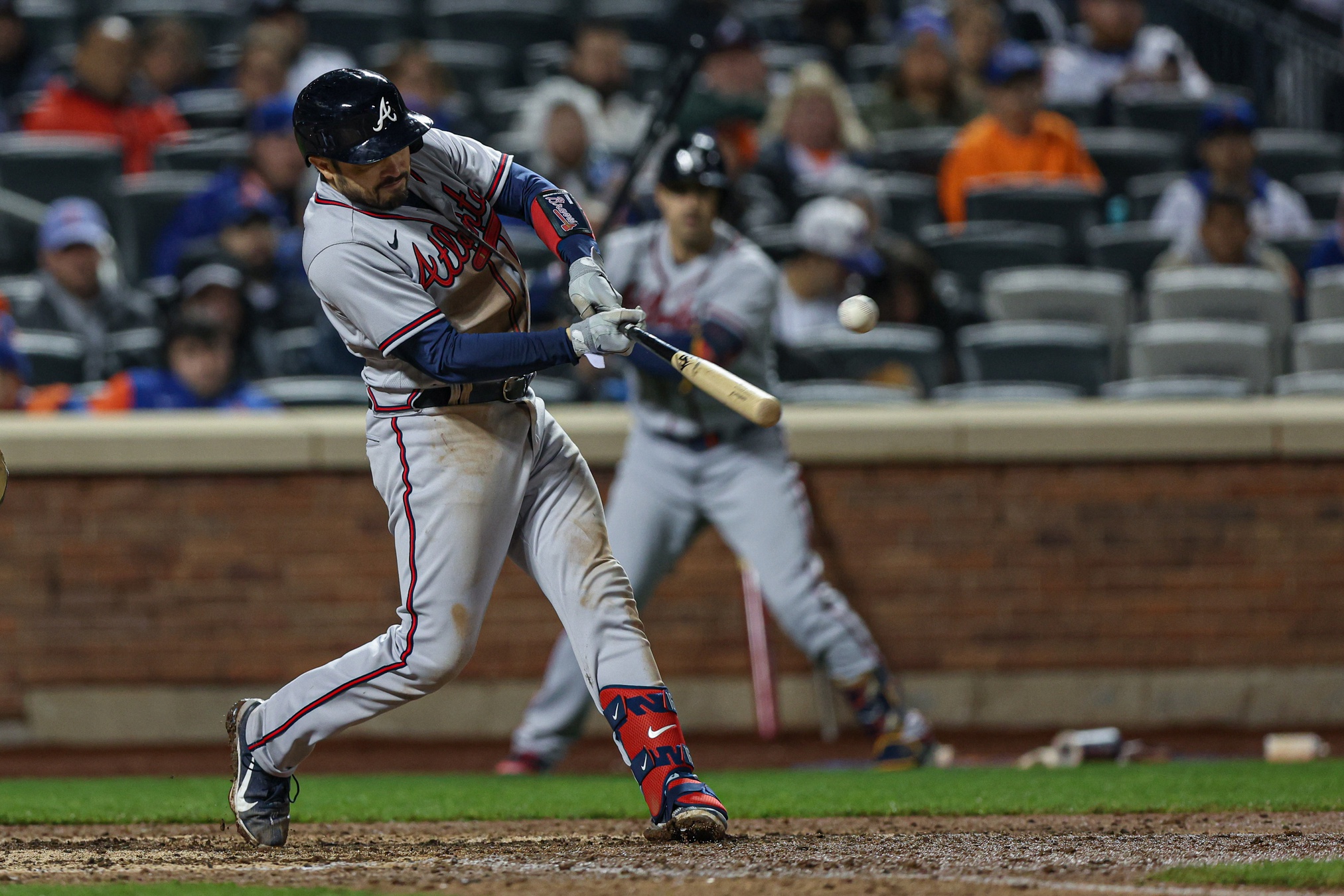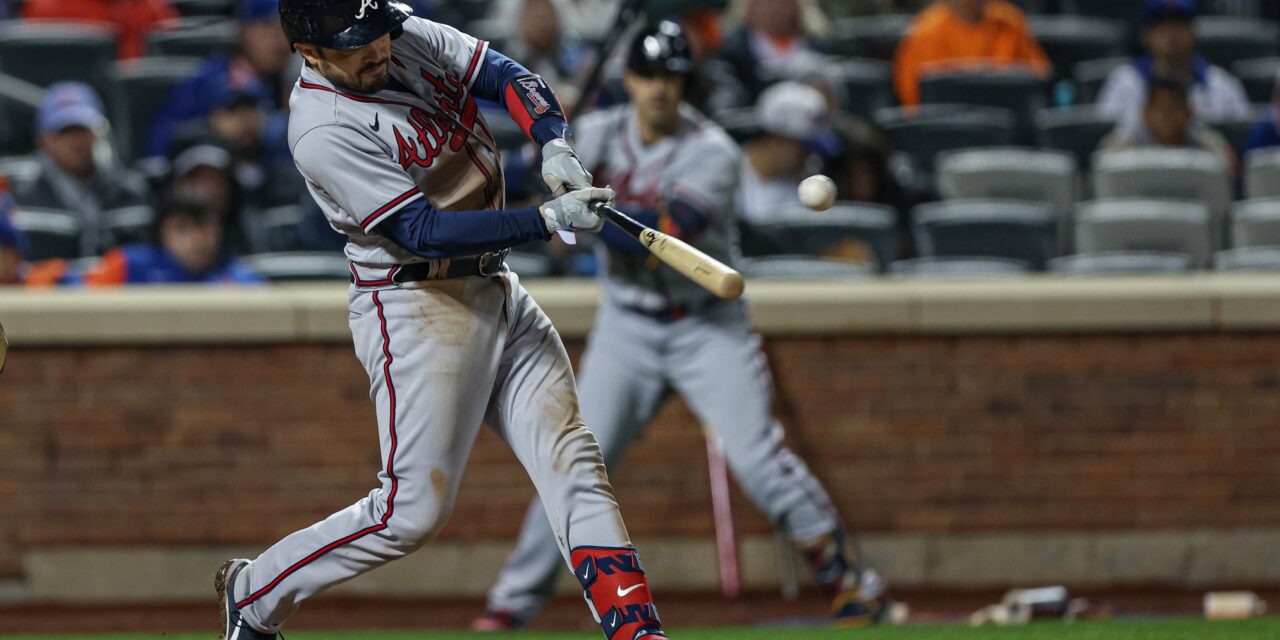
Travis d’Arnaud. Vincent Carchietta-USA TODAY Sports
There was a time when the Atlanta Braves didn’t always have the New York Mets’ number when it mattered most. Go back to 1969 and the inaugural NLCS. Atlanta actually came out of the West and were quickly gone in a best-of-five sweep. The first two players on our list of Mets-Braves overlap were part of that, but the ties between New York and Atlanta are few and far between aside from mutual dislike. Here’s a bit of source material for your future immaculate grids.
Gary Gentry – Mets (1969-72), Braves (1973-75)
In the shadow of a rotation headed by names like Koosman and Seaver, there was the 22-year-old rookie who won 13 times in ’69 with a 3.43 ERA and three shutouts. One of those came in the NL East clincher on September 24. He gave up only four hits and set off a wild Shea celebration. The party continued through the playoffs and through the World Series, where he was the winner in Game 3.
His career though did not go on an upward track following the championship year. He more or so leveled out and was no better than a league-average pitcher over the next three seasons. The Mets deemed him and reliever Danny Frisella, who regressed after an outstanding 1971 out of the bullpen, expendable enough to be dealt. It turned out to be a two-for-two swap. One player the Mets got in return was George Stone. The other? See below.
Félix Millán – Braves (1966-72), Mets (1973-77)
It became one of the best trades in the early history of the Mets. As it turned out, Gentry’s career never really recovered once in Atlanta. Millán, meanwhile, became the most underrated piece to the ’73 NL champs. He had already established himself with the Braves—making three All-Star teams and claiming a Gold Glove Award at second base. In a year when regulars were dropping like flies from injury, Millán played in 153 games and helped the Mets turn an NL–leading 179 double plays while hitting .290 and establishing a franchise record 185 hits as the No. 2 batter in the order.
While he could never come close to repeating his 1973, Millán remained steady. He typified the term everyday player and set team records for hits (191) and doubles (37) in 1975.
Joe Torre – Braves (1966-68), Mets (1975-77)
Torre played for the Braves and later played for the Mets. Then he immediately transitioned to managing the Mets before being fired and taking over the Braves gig. He was a superior player in Atlanta due to better surroundings and younger age. From 1963-68, he had an OPS+ of 135 and was an All-Star in all but one season. In a lineup that featured, among others, Hank Aaron, Torre drove in 100 or more runs twice even if his speed contributed to his league-leading double-play totals.
He was a more successful manager in Atlanta due to better surroundings and the lessons learned in New York. Torre took over the reins in Queens just as Tom Seaver was heading out and was given a thankless task. Being fired in 1981 turned out to be a blessing as he led the Braves to a division title in ’82.
Mike Hampton – Mets (2000), Braves (2003-05, 2008)
That Atlanta school system must be really good. Hampton’s only regular season in New York was good, but his postseason was great. From late March to late September, the left-hander had a 3.14 ERA and earned 15 victories. But he really justified in acquisition in October. Hampton strung together 16 consecutive scoreless innings against the St. Louis Cardinals, capped by a brilliant three-hit shutout in the clinching Game 5. He was rightfully named the series’ MVP.
Famously citing the superior Denver education system, Hampton bolted the Big Apple for Colorado. From there, he excelled as a hitting pitcher but his actual pitching never improved. His tenure with the Braves was interrupted by a two-year hiatus due to numerous injuries.
Tom Glavine – Braves (1987-2002, 2008), Mets (2003-07)
When thinking of great left-handed pitchers and the Atlanta Braves, it’s hard not to think of Glavine. When thinking of Glavine and the Mets, it’s impossible not to think of his final game. The Hall of Famer had a legendary meltdown in the opening inning of a must-win season finale versus Florida. After allowing seven runs, a five-season tenure marked by a 3.97 ERA and his 300th win just a few weeks ago was overshadowed. The Mets’ chances of a postseason berth went up in smoke and the collapse was all but complete. The frustration was amplified for several reasons, one being his dominance over New York during his time in Atlanta. In fairness, most teams couldn’t beat Glavine. From 1991-2002, he had an ERA+ of 134 and collected two Cy Youngs.
Billy Wagner – Mets (2006-09), Braves (2010)
If he makes the Hall of Fame, the highlights would be more Mets than Braves. That’s due to quantity than quality. By the end of his New York tenure, his arm wasn’t as strong as it was in Houston, Philadelphia, or during his initial years in Queens.
Wagner arrived to the Mets and became one of the best free-agent acquisitions. He saved 40 and pitched to a 2.24 ERA for the division-clinching ’06 club, finishing sixth in the NL Cy Young Award voting. Wagner was an All-Star for each of the next two seasons and ended up with a 10.9 strikeout/9 inning ratio before his 2008 was derailed by a significant elbow injury. An interlude with Boston preceded his joining the Braves, where he came back nicely with a 1.43 ERA over the last 71 games of his career.
Jeff Francoeur – Braves (2005-09), Mets (2009, 2010)
Full disclosure, it feels like Francoeur was on the Mets roster for more than two seasons. Maybe it was because we saw so much of him before then. Francoeur got to witness the successes and failures of New York from afar, then was right in the middle of it during Citi Field’s infancy. He was a decent hitter with a great outfield arm. His production at the plate over 75 games in 2009, coming over from Atlanta in a July trade, exceeded the performance in 2010 when he tailed off and was benched. At least his defense improved—he went from five assists for ’09 to 11 the very next year.
Travis d’Arnaud – Mets (2013-19), Braves (2020-present)
It can’t be forgotten that d’Arnaud was part of a terrific and timely trade with Toronto for Cy Young winner R.A. Dickey that also brought fellow Blue Jay prospect Noah Syndergaard into the Mets’ system. At his best, he helped the Mets win the 2015 National League pennant. At his worst, he was a liability at the plate and in the field.
By 2019, it was clear that d’Arnaud needed a change of scenery. It didn’t happen in Los Angeles or Tampa. Unfortunately for the Mets, the revival happened right within their division. Letting d’Arnaud go wasn’t a mistake by the Mets even as he’s found long-term success in Atlanta, as many seem to do.
















